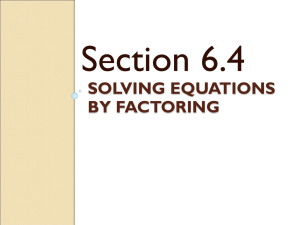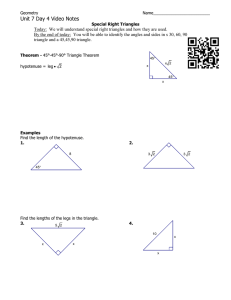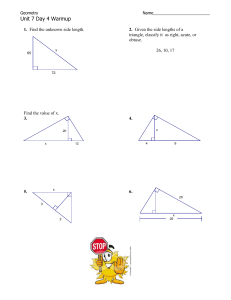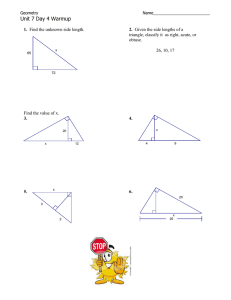Lesson 24: Prove the Pythagorean Theorem Using Similarity
advertisement
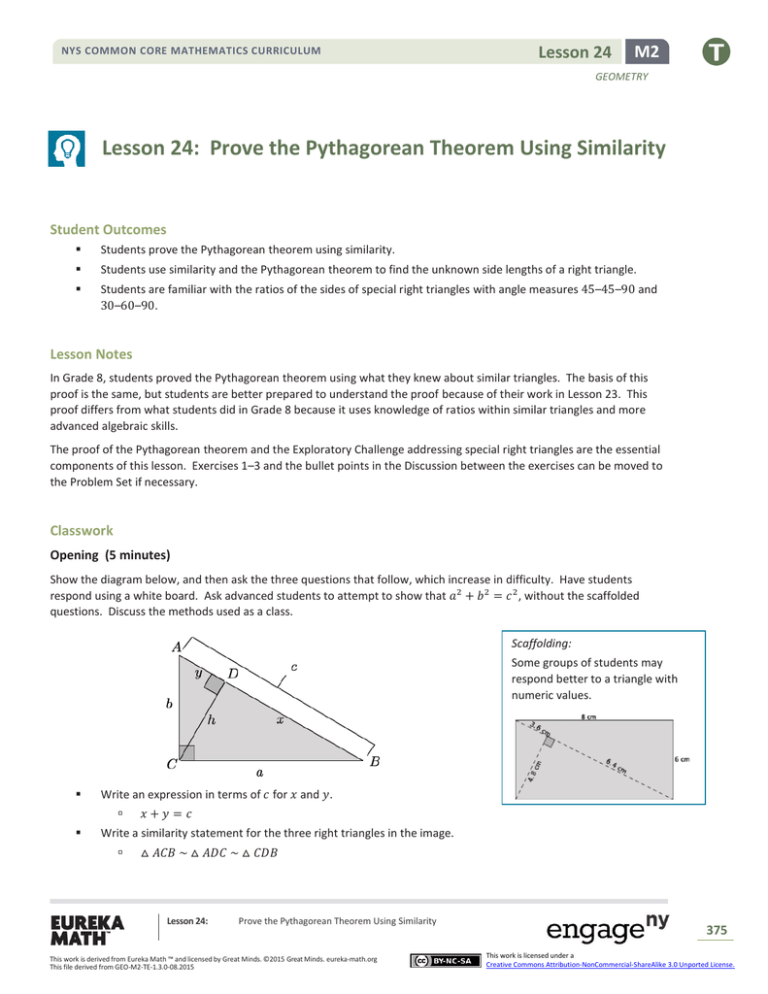
NYS COMMON CORE MATHEMATICS CURRICULUM Lesson 24 M2 GEOMETRY Lesson 24: Prove the Pythagorean Theorem Using Similarity Student Outcomes Students prove the Pythagorean theorem using similarity. Students use similarity and the Pythagorean theorem to find the unknown side lengths of a right triangle. Students are familiar with the ratios of the sides of special right triangles with angle measures 45–45–90 and 30–60–90. Lesson Notes In Grade 8, students proved the Pythagorean theorem using what they knew about similar triangles. The basis of this proof is the same, but students are better prepared to understand the proof because of their work in Lesson 23. This proof differs from what students did in Grade 8 because it uses knowledge of ratios within similar triangles and more advanced algebraic skills. The proof of the Pythagorean theorem and the Exploratory Challenge addressing special right triangles are the essential components of this lesson. Exercises 1–3 and the bullet points in the Discussion between the exercises can be moved to the Problem Set if necessary. Classwork Opening (5 minutes) Show the diagram below, and then ask the three questions that follow, which increase in difficulty. Have students respond using a white board. Ask advanced students to attempt to show that 𝑎2 + 𝑏 2 = 𝑐 2 , without the scaffolded questions. Discuss the methods used as a class. Scaffolding: Some groups of students may respond better to a triangle with numeric values. Write an expression in terms of 𝑐 for 𝑥 and 𝑦. Write a similarity statement for the three right triangles in the image. 𝑥+𝑦=𝑐 △ 𝐴𝐶𝐵 ~ △ 𝐴𝐷𝐶 ~ △ 𝐶𝐷𝐵 Lesson 24: Prove the Pythagorean Theorem Using Similarity This work is derived from Eureka Math ™ and licensed by Great Minds. ©2015 Great Minds. eureka-math.org This file derived from GEO-M2-TE-1.3.0-08.2015 375 This work is licensed under a Creative Commons Attribution-NonCommercial-ShareAlike 3.0 Unported License. NYS COMMON CORE MATHEMATICS CURRICULUM Lesson 24 M2 GEOMETRY Write a ratio based on the similarity statement from the previous question. Several answers are acceptable. Ensure that students are writing ratios as they did in Lesson 21, that is, ratios that compare shorter leg: hypotenuse, longer leg: hypotenuse, or shorter leg: longer leg. Discussion (10 minutes) In the Discussion that follows, students prove the Pythagorean theorem using similarity and the converse of the Pythagorean theorem using SSS for congruent triangles. Our goal is to prove the Pythagorean theorem using what we know about similar triangles. Consider the right triangle △ 𝐴𝐵𝐶 so that ∠𝐶 is a right angle. We label the side lengths 𝑎, 𝑏, and 𝑐 so that side length 𝑎 is opposite ∠𝐴, side length 𝑏 is opposite ∠𝐵, and hypotenuse 𝑐 is opposite ∠𝐶, as shown. Next, we draw the altitude, ℎ, from the right angle to the hypotenuse so that it splits the hypotenuse at point 𝐷 into lengths 𝑥 and 𝑦 so that 𝑥 + 𝑦 = 𝑐, as shown. Scaffolding: What do we know about the original triangle and the two sub-triangles? Students may want to use the cutouts that they created in Lesson 21. The three triangles are similar. If necessary, show students the set of three triangles in the diagram below. The original triangle and the two triangles formed by the altitude ℎ have been moved via rigid motions that make their corresponding sides and angles easier to see. Lesson 24: Prove the Pythagorean Theorem Using Similarity This work is derived from Eureka Math ™ and licensed by Great Minds. ©2015 Great Minds. eureka-math.org This file derived from GEO-M2-TE-1.3.0-08.2015 376 This work is licensed under a Creative Commons Attribution-NonCommercial-ShareAlike 3.0 Unported License. Lesson 24 NYS COMMON CORE MATHEMATICS CURRICULUM M2 GEOMETRY We want to prove the Pythagorean theorem using what we know about similar triangles and the ratios we wrote in Lesson 23, that is, shorter leg: hypotenuse, longer leg: hypotenuse, or shorter leg: longer leg. We begin by identifying the two triangles that each have ∠𝐵 as one of their angles. Which are they? The two triangles are △ 𝐴𝐵𝐶 and △ 𝐶𝐵𝐷. Since they are similar, we can write equivalent ratios of the two similar triangles we just named in terms of longer leg: hypotenuse. 𝑎 𝑥 = 𝑐 𝑎 𝑎2 = 𝑥𝑐 Now, identify two right triangles in the figure that each have ∠𝐴 as an acute angle. The two triangles are △ 𝐴𝐵𝐶 and △ 𝐴𝐶𝐷. Write equivalent ratios in terms of shorter leg: hypotenuse, and simplify as we just did: 𝑏 𝑦 = 𝑐 𝑏 𝑏 2 = 𝑦𝑐 Our goal is to show that 𝑎2 + 𝑏 2 = 𝑐 2 . We know that 𝑎2 = 𝑥𝑐 and 𝑏 2 = 𝑦𝑐. By substitution, 𝑎2 + 𝑏 2 = 𝑥𝑐 + 𝑦𝑐 = (𝑥 + 𝑦)𝑐 = 𝑐𝑐 = 𝑐2. (because 𝑥 + 𝑦 = 𝑐) Therefore, 𝑎2 + 𝑏 2 = 𝑐 2 , and we have proven the Pythagorean theorem using similarity. MP.6 Ask students to summarize the steps of the proof in writing or with a partner. We next show that the converse of the Pythagorean theorem is true. CONVERSE OF THE PYTHAGOREAN THEOREM: If a triangle has side lengths 𝑎, 𝑏, and 𝑐 so that 𝑎2 + 𝑏 2 = 𝑐 2 , then the triangle is a right triangle with 𝑐 as the length of the hypotenuse (the side opposite the right angle). In the diagram below, we have a triangle with side lengths 𝑎, 𝑏, and 𝑐. In this diagram, we have constructed a right triangle with side lengths 𝑎 and 𝑏. If time permits, actually show the construction. Draw a segment of length 𝑎, construct a line through one of the endpoints of segment 𝑎 that is perpendicular to 𝑎, mark a point along the perpendicular line that is equal to the length of 𝑏, and draw the hypotenuse c. Lesson 24: Prove the Pythagorean Theorem Using Similarity This work is derived from Eureka Math ™ and licensed by Great Minds. ©2015 Great Minds. eureka-math.org This file derived from GEO-M2-TE-1.3.0-08.2015 377 This work is licensed under a Creative Commons Attribution-NonCommercial-ShareAlike 3.0 Unported License. Lesson 24 NYS COMMON CORE MATHEMATICS CURRICULUM M2 GEOMETRY Consider the right triangle with leg lengths of 𝑎 and 𝑏. By the Pythagorean theorem, we know that 𝑎2 + 𝑏 2 = 𝑐 2 . Taking the square root of both sides gives the length of the hypotenuse as √𝑎2 + 𝑏 2 = 𝑐. Then, by SSS, the two triangles are congruent because both triangles have side lengths of 𝑎, 𝑏, and 𝑐. Therefore, the given triangle is a right triangle with a right angle that is opposite the side of length 𝑐. Exercises 1–2 (5 minutes) Students complete Exercise 1 independently. Exercise 2 is designed so that early finishers of Exercise 1 can begin thinking about the topic of the next discussion. If time allows, consider asking students why they do not need to consider the negative solution for 𝑐 2 = 12500, which is 𝑐 = ±50√5; they only consider 50√5 in our solution. The desired response is that the context is length; therefore, there is no need to consider a negative length. Exercises 1–2 1. Find the length of the hypotenuse of a right triangle whose legs have lengths 𝟓𝟎 and 𝟏𝟎𝟎. 𝒄𝟐 = 𝟓𝟎𝟐 + 𝟏𝟎𝟎𝟐 𝒄𝟐 = 𝟐𝟓𝟎𝟎 + 𝟏𝟎𝟎𝟎𝟎 𝒄𝟐 = 𝟏𝟐𝟓𝟎𝟎 √𝒄𝟐 = √𝟏𝟐𝟓𝟎𝟎 Scaffolding: Guide students’ thinking by asking, “How might similar triangles make the work in Exercise 1 easier?” 𝒄 = √𝟐𝟐 ⋅ 𝟓𝟓 𝒄 = 𝟐 ⋅ 𝟓𝟐 √𝟓 𝒄 = 𝟓𝟎√𝟓 2. Can you think of a simpler method for finding the length of the hypotenuse in Exercise 1? Explain. Accept any reasonable methods. Students may recall from Grade 8 that they can use what they know about similar triangles and scale factors to make their computations easier. Discussion (4 minutes) In the Discussion that follows, students use what they know about similar triangles to simplify their work from Exercise 1. To simplify our work with large numbers, as in the leg lengths of 50 and 100 from Exercise 1, we can find the greatest common factor (GCF) of 50 and 100 and then consider a similar triangle with those smaller side lengths. Since GCF(50, 100) = 50, we can use that GCF to determine the side lengths of a dilated triangle. Lesson 24: Prove the Pythagorean Theorem Using Similarity This work is derived from Eureka Math ™ and licensed by Great Minds. ©2015 Great Minds. eureka-math.org This file derived from GEO-M2-TE-1.3.0-08.2015 378 This work is licensed under a Creative Commons Attribution-NonCommercial-ShareAlike 3.0 Unported License. Lesson 24 NYS COMMON CORE MATHEMATICS CURRICULUM M2 GEOMETRY Specifically, we can consider a triangle that has been dilated by a scale factor of triangle with leg lengths 1 and 2. 1 50 , which produces a similar A triangle with leg lengths 1 and 2 has a hypotenuse length of √5. The original triangle has side lengths that are 50 times longer than this one; therefore, the length of the hypotenuse of the original triangle is 50√5. Exercise 3 (2 minutes) Students complete Exercise 3 independently. Exercise 3 3. Find the length of the hypotenuse of a right triangle whose legs have lengths 𝟕𝟓 and 𝟐𝟐𝟓. A right triangle with leg lengths 𝟕𝟓 and 𝟐𝟐𝟓 has leg lengths that are 𝟕𝟓 times longer than a triangle with leg lengths 𝟏 and 𝟑. A triangle with leg lengths 𝟏 and 𝟑 has a hypotenuse of length √𝟏𝟎. Therefore, the length of the hypotenuse of a triangle with leg lengths 𝟕𝟓 and 𝟐𝟐𝟓 is 𝟕𝟓√𝟏𝟎. Exploratory Challenge/Exercises 4–5 (10 minutes) This challenge reveals the relationships of special right triangles with angle measures 30–60–90 and 45–45–90. Divide the class so that one half investigates the 30–60–90 triangle and the other half investigates the 45–45–90 triangle. Consider having pairs of students from each half become one small group to share their results. Another option is to discuss the results as a whole class using the closing questions below. Exploratory Challenge/Exercises 4–5 4. An equilateral triangle has sides of length 𝟐 and angle measures of 𝟔𝟎°, as shown below. The altitude from one vertex to the opposite side divides the triangle into two right triangles. a. Are those triangles congruent? Explain. Yes, the two right triangles are congruent by ASA. Since the altitude is perpendicular to the base, then each of the right triangles has angles of measure 𝟗𝟎° and 𝟔𝟎°. By the triangle sum theorem, the third angle has a measure of 𝟑𝟎°. Then, each of the right triangles has corresponding angle measures of 𝟑𝟎° and 𝟔𝟎°, and the included side length is 𝟐. Lesson 24: Prove the Pythagorean Theorem Using Similarity This work is derived from Eureka Math ™ and licensed by Great Minds. ©2015 Great Minds. eureka-math.org This file derived from GEO-M2-TE-1.3.0-08.2015 379 This work is licensed under a Creative Commons Attribution-NonCommercial-ShareAlike 3.0 Unported License. Lesson 24 NYS COMMON CORE MATHEMATICS CURRICULUM M2 GEOMETRY b. What is the length of the shorter leg of each of the right triangles? Explain. Since the total length of the base of the equilateral triangle is 𝟐, and the two right triangles formed are congruent, then the bases of each must be equal in length. Therefore, the length of the base of one right triangle is 𝟏. c. Use the Pythagorean theorem to determine the length of the altitude. Let 𝒉 represent the length of the altitude. 𝟏𝟐 + 𝒉𝟐 = 𝟐𝟐 𝒉𝟐 = 𝟐𝟐 − 𝟏𝟐 𝒉𝟐 = 𝟑 𝒉 = √𝟑 d. Write the ratio that represents shorter leg: hypotenuse. 𝟏: 𝟐 e. Write the ratio that represents longer leg: hypotenuse. √𝟑: 𝟐 f. Write the ratio that represents shorter leg: longer leg. 𝟏: √𝟑 g. By the AA criterion, any triangles with measures 𝟑𝟎–𝟔𝟎–𝟗𝟎 will be similar to this triangle. If a 𝟑𝟎–𝟔𝟎–𝟗𝟎 triangle has a hypotenuse of length 𝟏𝟔, what are the lengths of the legs? Consider providing the following picture for students: Let 𝒂 represent the length of the shorter leg. 𝒂 𝟏 = 𝟏𝟔 𝟐 𝒂=𝟖 Let 𝒃 represent the length of the longer leg. 𝒃 √𝟑 = 𝟏𝟔 𝟐 𝟐𝒃 = 𝟏𝟔√𝟑 𝒃 = 𝟖√𝟑 The length 𝒂 = 𝟖, and the length 𝒃 = 𝟖√𝟑. Note: After finding the length of one of the legs, some students may have used the ratio shorter leg: longer leg to determine the length of the other leg. Lesson 24: Prove the Pythagorean Theorem Using Similarity This work is derived from Eureka Math ™ and licensed by Great Minds. ©2015 Great Minds. eureka-math.org This file derived from GEO-M2-TE-1.3.0-08.2015 380 This work is licensed under a Creative Commons Attribution-NonCommercial-ShareAlike 3.0 Unported License. Lesson 24 NYS COMMON CORE MATHEMATICS CURRICULUM M2 GEOMETRY 5. An isosceles right triangle has leg lengths of 𝟏, as shown. a. What are the measures of the other two angles? Explain. Base angles of an isosceles triangle are equal; therefore, the other two angles have a measure of 𝟒𝟓°. b. Use the Pythagorean theorem to determine the length of the hypotenuse of the right triangle. Let 𝒄 represent the length of the hypotenuse. 𝟏𝟐 + 𝟏𝟐 = 𝒄𝟐 𝟐 = 𝒄𝟐 √𝟐 = 𝒄 c. Is it necessary to write all three ratios: shorter leg: hypotenuse, longer leg: hypotenuse, and shorter leg: longer leg? Explain. No, it is not necessary to write all three ratios. The reason is that the shorter leg and the longer leg are the same length. Therefore, the ratios shorter leg: hypotenuse and longer leg: hypotenuse will be the same. Additionally, the shorter leg: longer leg ratio would be 𝟏: 𝟏, which is not useful since we are given that the right triangle is an isosceles right triangle. d. Write the ratio that represents leg: hypotenuse. 𝟏: √𝟐 e. By the AA criterion, any triangles with measures 𝟒𝟓–𝟒𝟓–𝟗𝟎 will be similar to this triangle. If a 𝟒𝟓–𝟒𝟓–𝟗𝟎 triangle has a hypotenuse of length 𝟐𝟎, what are the lengths of the legs? Let 𝒂 represent the length of the leg. 𝒂 𝟏 = 𝟐𝟎 √𝟐 𝒂√𝟐 = 𝟐𝟎 𝒂= 𝟐𝟎 √𝟐 𝒂= 𝟐𝟎 √𝟐 ( ) √𝟐 √𝟐 𝒂= 𝟐𝟎√𝟐 𝟐 𝒂 = 𝟏𝟎√𝟐 Lesson 24: Prove the Pythagorean Theorem Using Similarity This work is derived from Eureka Math ™ and licensed by Great Minds. ©2015 Great Minds. eureka-math.org This file derived from GEO-M2-TE-1.3.0-08.2015 381 This work is licensed under a Creative Commons Attribution-NonCommercial-ShareAlike 3.0 Unported License. Lesson 24 NYS COMMON CORE MATHEMATICS CURRICULUM M2 GEOMETRY Closing (4 minutes) Ask students to summarize the key points of the lesson. Additionally, consider asking students the following questions. Have students respond in writing, to a partner, or to the whole class. Explain in your own words the proof of the Pythagorean theorem using similarity. Triangles with angle measures 30–60–90 are a result of drawing an altitude from one angle of an equilateral triangle to the opposite side. Explain how to use ratios of legs and the hypotenuse to find the lengths of any 30–60–90 triangle. Why does it work? Triangles with angle measures 45–45–90 are isosceles right triangles. Explain how to use ratios of legs and the hypotenuse to find the lengths of any 45–45–90 triangle. Why does it work? Exit Ticket (5 minutes) Lesson 24: Prove the Pythagorean Theorem Using Similarity This work is derived from Eureka Math ™ and licensed by Great Minds. ©2015 Great Minds. eureka-math.org This file derived from GEO-M2-TE-1.3.0-08.2015 382 This work is licensed under a Creative Commons Attribution-NonCommercial-ShareAlike 3.0 Unported License. Lesson 24 NYS COMMON CORE MATHEMATICS CURRICULUM M2 GEOMETRY Name Date Lesson 24: Prove the Pythagorean Theorem Using Similarity Exit Ticket A right triangle has a leg with a length of 18 and a hypotenuse with a length of 36. Bernie notices that the hypotenuse is twice the length of the given leg, which means it is a 30–60–90 triangle. If Bernie is right, what should the length of the remaining leg be? Explain your answer. Confirm your answer using the Pythagorean theorem. Lesson 24: Prove the Pythagorean Theorem Using Similarity This work is derived from Eureka Math ™ and licensed by Great Minds. ©2015 Great Minds. eureka-math.org This file derived from GEO-M2-TE-1.3.0-08.2015 383 This work is licensed under a Creative Commons Attribution-NonCommercial-ShareAlike 3.0 Unported License. Lesson 24 NYS COMMON CORE MATHEMATICS CURRICULUM M2 GEOMETRY Exit Ticket Sample Solutions A right triangle has a leg with a length of 𝟏𝟖 and a hypotenuse with a length of 𝟑𝟔. Bernie notices that the hypotenuse is twice the length of the given leg, which means it is a 𝟑𝟎–𝟔𝟎–𝟗𝟎 triangle. If Bernie is right, what should the length of the remaining leg be? Explain your answer. Confirm your answer using the Pythagorean theorem. A right angle and two given sides of a triangle determine a unique triangle. All 𝟑𝟎–𝟔𝟎–𝟗𝟎 triangles are similar by AA criterion, and the lengths of their sides are 𝟏𝒄, 𝟐𝒄, and 𝒄√𝟑, for some positive number 𝒄. The given hypotenuse is twice the length of the given leg of the right triangle, so Bernie’s conclusion is accurate. The ratio of the length of the short leg to the length of the longer leg of any 𝟑𝟎–𝟔𝟎–𝟗𝟎 triangle is 𝟏: √𝟑. The given leg has a length of 𝟏𝟖, which is 𝟏 𝟐 of the hypotenuse and, therefore, must be the shorter leg of the triangle. 𝟏 𝟏𝟖 = √𝟑 𝐥𝐞𝐠𝟐 𝐥𝐞𝐠 𝟐 = 𝟏𝟖√𝟑 𝟏𝟖𝟐 + 𝐥𝐞𝐠𝟐 = 𝟑𝟔𝟐 𝟑𝟐𝟒 + 𝐥𝐞𝐠𝟐 = 𝟏𝟐𝟗𝟔 𝐥𝐞𝐠𝟐 = 𝟗𝟕𝟐 𝐥𝐞𝐠 = √𝟗𝟕𝟐 𝐥𝐞𝐠 = √𝟑𝟐𝟒√𝟑 𝐥𝐞𝐠 = 𝟏𝟖√𝟑 Problem Set Sample Solutions 1. In each row of the table below are the lengths of the legs and hypotenuses of different right triangles. Find the missing side lengths in each row, in simplest radical form. 𝐋𝐞𝐠𝟏 𝟏𝟓 𝟏𝟓 𝟑 𝟏𝟎𝟎 𝐋𝐞𝐠𝟐 𝟐𝟎 𝟑𝟔 𝟐√𝟏𝟎 𝟐𝟎𝟎 𝐇𝐲𝐩𝐨𝐭𝐞𝐧𝐮𝐬𝐞 𝟐𝟓 𝟑𝟗 𝟕 𝟏𝟎𝟎√𝟓 Answers provided in table By the Pythagorean theorem: 𝐥𝐞𝐠 𝟐𝟏 + 𝐥𝐞𝐠 𝟐𝟏 = 𝐡𝐲𝐩𝟐 𝟏𝟓𝟐 + 𝒚𝟐 = 𝟐𝟓𝟐 𝟐𝟐𝟓 + 𝒚𝟐 = 𝟔𝟐𝟓 𝒚𝟐 = 𝟒𝟎𝟎 𝒚 = 𝟐𝟎 or 𝒚 = −𝟐𝟎 The case where 𝒚 = −𝟐𝟎 does not make sense since it represents a length of a side of a triangle and is, therefore, disregarded. Alternative strategy: Divide each side length by the greatest common factor to get the side lengths of a similar right triangle. Find the missing side length for the similar triangle, and multiply by the GCF. 𝐋𝐞𝐠: 𝟏𝟓, 𝐇𝐲𝐩𝐨𝐭𝐞𝐧𝐮𝐬𝐞: 𝟐𝟓, 𝐆𝐂𝐅(𝟏𝟓, 𝟐𝟓) = 𝟓 Consider the triangle with 𝐋𝐞𝐠: 𝟑 and 𝐇𝐲𝐩𝐨𝐭𝐞𝐧𝐮𝐬𝐞: 𝟓. This is a 𝟑–𝟒–𝟓 right triangle. The missing leg length is 𝟓 ⋅ 𝟒 = 𝟐𝟎. 𝐋𝐞𝐠𝐬: 𝟏𝟎𝟎 and 𝟐𝟎𝟎: 𝐆𝐂𝐅(𝟏𝟎𝟎, 𝟐𝟎𝟎) = 𝟏𝟎𝟎 Lesson 24: Prove the Pythagorean Theorem Using Similarity This work is derived from Eureka Math ™ and licensed by Great Minds. ©2015 Great Minds. eureka-math.org This file derived from GEO-M2-TE-1.3.0-08.2015 384 This work is licensed under a Creative Commons Attribution-NonCommercial-ShareAlike 3.0 Unported License. Lesson 24 NYS COMMON CORE MATHEMATICS CURRICULUM M2 GEOMETRY Consider the right triangle with 𝐋𝐞𝐠𝐬: 𝟏 and 𝟐. 𝐇𝐲𝐩𝐨𝐭𝐞𝐧𝐮𝐬𝐞 = √𝟓. The missing hypotenuse length is 𝟏𝟎𝟎√𝟓. 2. Claude sailed his boat due south for 𝟑𝟖 miles and then due west for 𝟐𝟓 miles. Approximately how far is Claude from where he began? Claude’s path forms a right triangle since south and west are perpendicular to each other. His distance from where he began is a straight line segment represented by the hypotenuse of the triangle. 𝟑𝟖𝟐 + 𝟐𝟓𝟐 = 𝐡𝐲𝐩𝟐 𝟏𝟒𝟒𝟒 + 𝟔𝟐𝟓 = 𝐡𝐲𝐩𝟐 𝟐𝟎𝟔𝟗 = 𝐡𝐲𝐩𝟐 √𝟐𝟎𝟔𝟗 = 𝐡𝐲𝐩 Claude is approximately 𝟒𝟓. 𝟓 miles from where he began. 3. Find the lengths of the legs in the triangle given the hypotenuse with length 𝟏𝟎𝟎. By the Pythagorean theorem: 𝐥𝐞𝐠 𝟐 + 𝐥𝐞𝐠 𝟐 = 𝟏𝟎𝟎𝟐 𝟐 𝐥𝐞𝐠 𝟐 = 𝟏𝟎𝟎𝟎𝟎 𝐥𝐞𝐠 𝟐 = 𝟓𝟎𝟎𝟎 𝐥𝐞𝐠 = √𝟓𝟎𝟎𝟎 𝐥𝐞𝐠 = √𝟐𝟓𝟎𝟎√𝟐 𝐥𝐞𝐠 = 𝟓𝟎√𝟐 Alternative strategy: The right triangle is an isosceles right triangle, so the leg lengths are equal. The hypotenuse of an isosceles right triangle can be calculated as follows: 𝐡𝐲𝐩 = 𝐥𝐞𝐠 ⋅ √𝟐 𝟏𝟎𝟎 = 𝐥𝐞𝐠√𝟐 𝟏𝟎𝟎 = 𝐥𝐞𝐠 √𝟐 𝟏𝟎𝟎√𝟐 = 𝟓𝟎√𝟐 = 𝐥𝐞𝐠 𝟐 The legs of the 45–45–90 right triangle with a hypotenuse of 𝟏𝟎𝟎 are 𝟓𝟎√𝟐. 4. Find the length of the hypotenuse in the right triangle given that the legs have lengths of 𝟏𝟎𝟎. By the Pythagorean theorem: 𝟏𝟎𝟎𝟐 + 𝟏𝟎𝟎𝟐 = 𝐡𝐲𝐩𝟐 𝟏𝟎𝟎𝟎𝟎 + 𝟏𝟎𝟎𝟎𝟎 = 𝐡𝐲𝐩𝟐 𝟐𝟎𝟎𝟎𝟎 = 𝐡𝐲𝐩𝟐 √𝟐𝟎𝟎𝟎𝟎 = 𝐡𝐲𝐩 √𝟏𝟎𝟎𝟎𝟎√𝟐 = 𝐡𝐲𝐩𝟐 𝟏𝟎𝟎√𝟐 = 𝐡𝐲𝐩 Alternative strategy: The given right triangle is a 𝟒𝟓–𝟒𝟓–𝟗𝟎 triangle. Therefore, the ratio of the length of its legs to the length of its hypotenuse is 𝟏: √𝟐. 𝐡𝐲𝐩 = 𝐥𝐞𝐠 ⋅ √𝟐 𝐡𝐲𝐩 = 𝟏𝟎𝟎√𝟐 Lesson 24: Prove the Pythagorean Theorem Using Similarity This work is derived from Eureka Math ™ and licensed by Great Minds. ©2015 Great Minds. eureka-math.org This file derived from GEO-M2-TE-1.3.0-08.2015 385 This work is licensed under a Creative Commons Attribution-NonCommercial-ShareAlike 3.0 Unported License. Lesson 24 NYS COMMON CORE MATHEMATICS CURRICULUM M2 GEOMETRY The hypotenuse of the right triangle with legs of length 𝟏𝟎𝟎 is 𝟏𝟎𝟎√𝟐. Each row in the table below shows the side lengths of a different 𝟑𝟎–𝟔𝟎–𝟗𝟎 right triangle. Complete the table with the missing side lengths in simplest radical form. Use the relationships of the values in the first three rows to complete the last row. How could the expressions in the last row be used? Shorter Leg 𝟐𝟓 𝟏𝟓 Longer Leg 𝟐𝟓√𝟑 𝟏𝟓√𝟑 𝟑 √𝟑 𝒙 𝒙√𝟑 Hypotenuse 𝟓𝟎 𝟑𝟎 𝟐√𝟑 𝟐𝒙 The last row of the table shows that the sides of a 𝟑𝟎–𝟔𝟎–𝟗𝟎 right triangle are multiples of 𝟏, 𝟐, and √𝟑 by some constant 𝒙, with 𝟐𝒙 being the longest and, therefore, the hypotenuse. The expressions could be used to find two unknown sides of a 𝟑𝟎–𝟔𝟎–𝟗𝟎 triangle where only one of the sides is known. . 5. ̅̅̅̅ that splits the side 𝑨𝑩 ̅̅̅̅ into In right triangle 𝑨𝑩𝑪 with ∠𝑪 a right angle, an altitude of length 𝒉 is dropped to side 𝑨𝑩 segments of length 𝒙 and 𝒚. Use the Pythagorean theorem to show 𝒉𝟐 = 𝒙𝒚. By the Pythagorean theorem, 𝒂𝟐 + 𝒃𝟐 = 𝒄𝟐. Since 𝒄 = 𝒙 + 𝒚, we have 𝒂𝟐 + 𝒃𝟐 = (𝒙 + 𝒚)𝟐 𝒂𝟐 + 𝒃𝟐 = 𝒙𝟐 + 𝟐𝒙𝒚 + 𝒚𝟐 . Also by the Pythagorean theorem, 𝒂𝟐 = 𝒉𝟐 + 𝒚𝟐 , and 𝒃𝟐 = 𝒉𝟐 + 𝒙𝟐 , so 𝒂𝟐 + 𝒃𝟐 = 𝒉𝟐 + 𝒚𝟐 + 𝒉𝟐 + 𝒙𝟐 𝒂𝟐 + 𝒃𝟐 = 𝟐𝒉𝟐 + 𝒙𝟐 + 𝒚𝟐 . Thus, by substitution, 𝒙𝟐 + 𝟐𝒙𝒚 + 𝒚𝟐 = 𝟐𝒉𝟐 + 𝒙𝟐 + 𝒚𝟐 𝟐𝒙𝒚 = 𝟐𝒉𝟐 𝒙𝒚 = 𝒉𝟐 . 6. In triangle 𝑨𝑩𝑪, the altitude from ∠𝑪 splits side ̅̅̅̅ 𝑨𝑩 into two segments of lengths 𝒙 and 𝒚. If 𝒉 denotes the length of the altitude and 𝒉𝟐 = 𝒙𝒚, use the Pythagorean theorem and its converse to show that triangle 𝑨𝑩𝑪 is a right triangle with ∠𝑪 a right angle. Let 𝒂, 𝒃, and 𝒄 be the lengths of the sides of the triangle opposite ∠𝑨, ∠𝑩, and ∠𝑪, respectively. By the Pythagorean theorem: 𝒂𝟐 = 𝒉𝟐 + 𝒚𝟐 and 𝒃𝟐 = 𝒉𝟐 + 𝒙𝟐 , so 𝒂𝟐 + 𝒃𝟐 = 𝒉𝟐 + 𝒚𝟐 + 𝒉𝟐 + 𝒙𝟐 𝒂𝟐 + 𝒃𝟐 = 𝒙𝟐 + 𝟐𝒉𝟐 + 𝒚𝟐 𝒂𝟐 + 𝒃𝟐 = 𝒙𝟐 + 𝟐𝒙𝒚 + 𝒚𝟐 𝒂𝟐 + 𝒃𝟐 = (𝒙 + 𝒚)𝟐 𝒂 𝟐 + 𝒃 𝟐 = 𝒄𝟐 . So, by the converse of the Pythagorean theorem, △ 𝑨𝑩𝑪 is a right triangle, 𝒂 and 𝒃 are the lengths of legs of the triangle, and 𝒄 is the hypotenuse, which lies opposite the right angle. Therefore, ∠𝑪 is the right angle of the right Lesson 24: Prove the Pythagorean Theorem Using Similarity This work is derived from Eureka Math ™ and licensed by Great Minds. ©2015 Great Minds. eureka-math.org This file derived from GEO-M2-TE-1.3.0-08.2015 386 This work is licensed under a Creative Commons Attribution-NonCommercial-ShareAlike 3.0 Unported License. NYS COMMON CORE MATHEMATICS CURRICULUM Lesson 24 M2 GEOMETRY triangle. Lesson 24: Prove the Pythagorean Theorem Using Similarity This work is derived from Eureka Math ™ and licensed by Great Minds. ©2015 Great Minds. eureka-math.org This file derived from GEO-M2-TE-1.3.0-08.2015 387 This work is licensed under a Creative Commons Attribution-NonCommercial-ShareAlike 3.0 Unported License.

